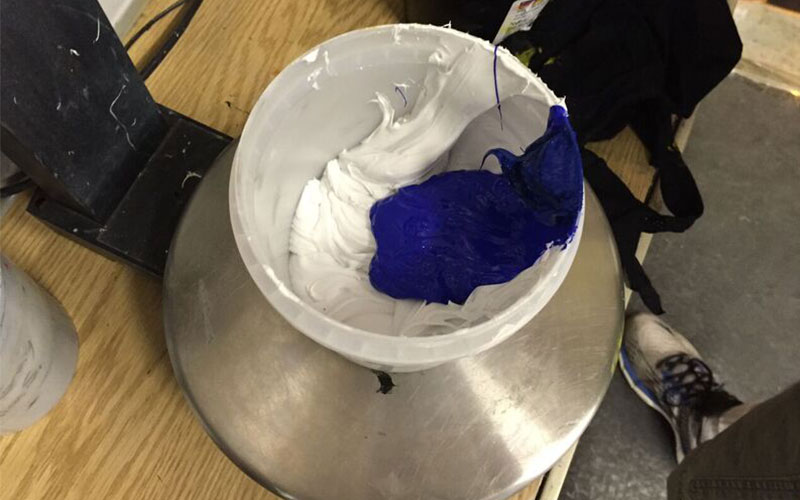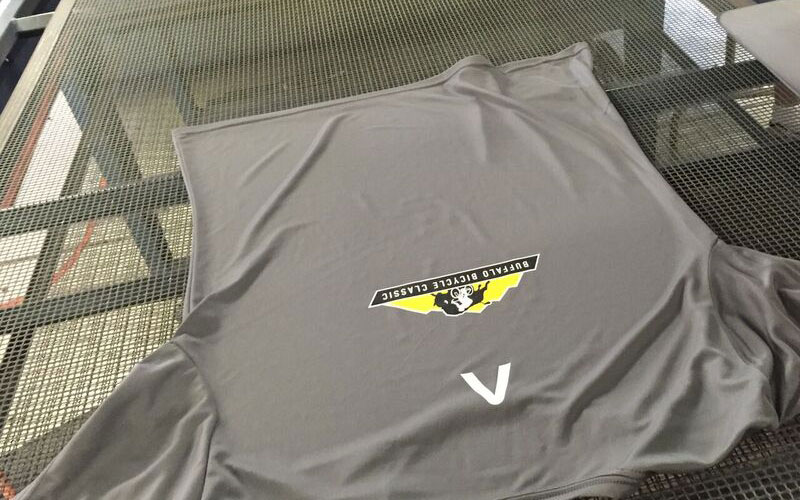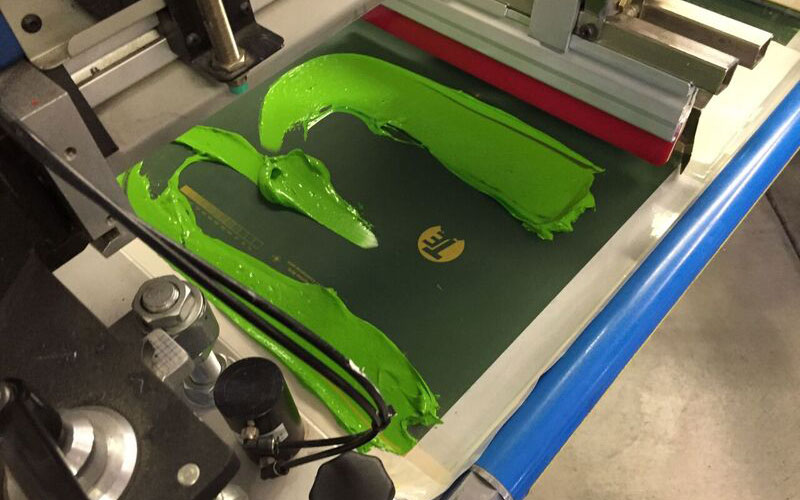Strategy November 16, 2017
High Performance at Low Temperatures
Screen printing on synthetic materials like polyester requires special considerations to prevent dye migration and fabric shrinkage.
Screen printers have always struggled a bit with even cotton/polyester blends. While dyes absorb into cotton completely, they will set on top of the polyester threads. Under heat, these dyes release as a gas from the polyester threads and float in your ink. This is called dye migration.
 Low temperature ink being mixed. These inks are available as an additive to plastisol or as a premixed product. Photos courtesy of Lon Winters, Graphic Elephants.
Low temperature ink being mixed. These inks are available as an additive to plastisol or as a premixed product. Photos courtesy of Lon Winters, Graphic Elephants.
An example is a white print on a red 50-50 cotton-polyester garment. Using standard plastisol or running your dryer too hot will result in a pink image coming out of the dryer tunnel. This can also occur when garments are stacked hot, which can draw the dye out of the shirt placed on top of the printed image.
When printing a 50-50 cotton-polyester garment (or similar blend), a screen printer can control dye migration by using a low-bleed plastisol ink and by setting the dryer temperature as low as possible for the ink system, but still curing the ink.
Most screen printers who primarily print on 100% cotton tend to allow their dryer temperatures to run a little high to ensure a good cure. Printing on a polyester blend requires you to zero in on the recommended curing temperature for your ink, normally in the range of 320 degrees.
 Performance wear garments on the dryer at Graphic Elephants. Curing is in the range of 275 degrees.
Performance wear garments on the dryer at Graphic Elephants. Curing is in the range of 275 degrees.
The popularity of 100% polyester performance wear has added new wrinkles to the printing process. There are three issues with these garments. One is dye migration. The second is the fabric’s tendency to shrink, or even melt, when cured at normal plastisol temperature. Third, these fabrics are typically more stretchable so low-cure inks work best, in comparison with standard plastisol inks.
Polyester performance wear and synthetic-blended fabrics are often a catchall for any 100% manmade fabrics. Their reaction to dye migration and shrinkage under heat will vary from brand to brand and blend to blend, but printing any of these synthetic fabrics will be a similar process.
The answer is in an ink that cures at a lower temperature than normal plastisol. On average, this lower temperature will be about 275 degrees. The cure temperature varies among ink brands, but all will be in that 275-degree range.
There are two approaches to low-temperature ink. The first is an additive you mix with your standard plastisol inks. Anyone who has experimented with different fabrics such as water-repellant nylon knows that certain additives allow us to manipulate plastisol inks to our own needs. You’ll need a gram scale to properly mix ink and additive. Carefully follow the ink manufacturer instructions to be successful.
The other option is premixed low-temperature inks, which come either already prepared in the container, or as bases that can be mixed. Many decorators find the premixed low-temperature inks show more consistency from batch to batch (and print run to print run) than using a plastisol with low-temperature additive.
 Performance wear garments being printed on an automatic press.
Performance wear garments being printed on an automatic press.
As with all new ink systems and new fabrics, experiment, experiment, experiment before shipping out your first order of performance wear. This experimentation means some potentially spoiled garments and multiple wash tests.
There’s a misconception in the industry that using a low-cure ink as an underbase will allow you to use your standard plastisol inks on top. This is not correct. Even when printed upon a low-cure ink, standard plastisols still need to be cured in the range of 320 degrees, thus defeating the purpose of a low-temperature ink product.
It’s truly just a matter of time for garment decorators to face the task of printing popular performance wear garments using low-temperature inks. So, why not take the plunge now?
***
Terry Combs is a 35-plus-year veteran of the garment-printing industry and has managed production shops large and small across the United States. He has written hundreds of management and technical articles for garment-printing publications and spoken at industry events worldwide. He is currently in sales and training with Equipment Zone, Franklin Lakes, NJ, working from Scottsdale, AZ.
